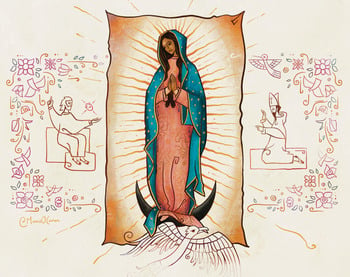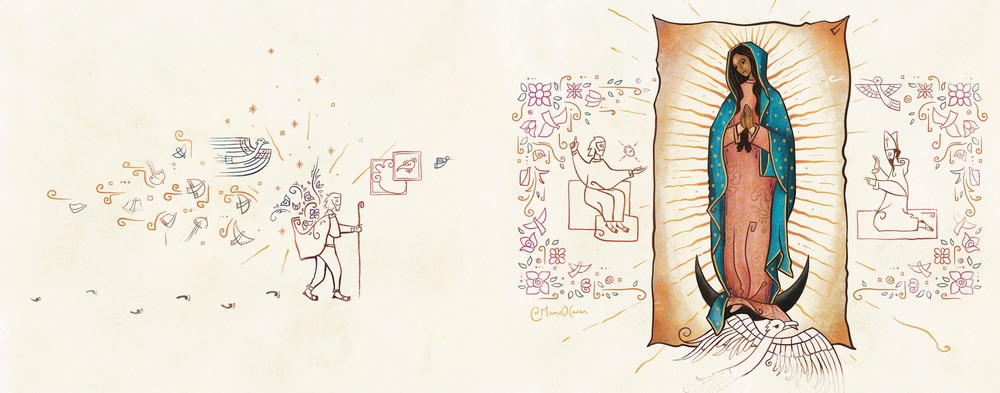-
 December 12, 2023
December 12, 2023By Fr. Manu Franco-Gomez, O.Carm.
There is a widespread notion that Europe brought knowledge, civilization, and, of course, faith to pre-Hispanic Mexico. Our Lady of Guadalupe has been credited with successfully evangelizing the indigenous people, who were believed to resist accepting God. However, if we carefully read the history of the apparitions in the Nican Mopohua, we find a somewhat different reality.
Numerous sources agree that the natives of pre-Hispanic Mexico were intelligent and had a sophisticated culture. For them, the highest form of wisdom was composing poetry and songs about the divine. Classical Nahuatl is a language as elaborate as Latin, with an extensive and sophisticated vocabulary capable of conveying abstract and profound ideas about the divine and the greatness of the human person. Art and spirituality were not inferior to warfare; poets and sages were held in no lesser esteem than warriors. The ancient Nahua people left us evidence of their thirst for mystery. [1]
To understand Juan Diego and Guadalupe, we need to carefully read the Nican Mopohua, a beautiful work of Hispano-Nahuatl literature that represents a link between Nahua mysticism and Christian spirituality. Upon reading it, it's surprising to discover that Juan Diego is the one with total openness to the divine, and through him, the bishop comes to understand that God also dwelt in these lands. The miracle of Guadalupe confirms the capacity of the pre-Hispanic people to live, understand, and communicate with God. It's not an exaggeration to claim that Juan Diego is a mystic on par with the Carmelite saint, John of the Cross. Just as the Spanish mystic found words to speak of the relationship between the soul and God, our esteemed Mexican found songs (birds) and flowers to soften the bishop's heart. In the ancient world, one who finds songs (xochilt) and flowers (cuicatl) is a mystic. Juan Diego was a Temoama, one who carries a sacred ofrenda: the tilma. He was also a Tlamatini, a teacher in divine matters. Juan Diego is a spiritual teacher whom we can approach to help express our experience of God. [2]
Guadalupe helped both peoples understand that they were siblings. Those who believed themselves superior in faith and culture were more cruel than we like to admit. Let's not forget that it was Bishop Fray Juan de Sumárraga who underwent a conversion after the apparitions of the Virgin of Guadalupe. Juan Diego did not have it easy; it took him three visits! The native Mexicans were more in tune with the things of God than we like to admit. As St. John Paul II said in his homily for the canonization of Juan Diego: "Consequently, Guadalupe and Juan Diego have a deep ecclesial and missionary meaning and are a model of perfectly inculturated evangelization." [3]
The life of Juan Diego is much more than the biography of an indigenous person converted to Christianity; it "facilitated the fruitful encounter of two worlds." [3] Juan Diego was a mystic, a teacher in divine matters. Our beloved saint teaches us that each person, within the diversity of races and ages, carries a divine spark, the image of God, already bright and burning from the beginning of life; it is a flame that takes different forms according to our culture and race. In short, our beloved Juan Diego is a testimony to our innate inclination to know and encounter God.
Saint Juan Diego, pray for us!
[1] León Portilla, Miguel. Fifteen Poets of the Aztec World. 1st ed., University of Oklahoma Press, 1992.
[2] León Portilla, Miguel, and Antonio Valeriano. Tonantzin Guadalupe : pensamiento náhuatl y mensaje cristiano en el “Nicān mopōhua.” 1. ed, Colegio Nacional, 2000.
[3] John Paul II. "Canonization Of Juan Diego Cuauhtlatoatzin, Homily Of The Holy Father John Paul II." www.Vatican.Va, 31 Jul. 2002.

